Ethanol, or ethyl alcohol, is a type of biofuel produced from organic matter like corn, sugarcane, grasses, agricultural waste, and even garbage.
The largest sources of ethanol are corn kernels in the United States and sugarcane in Brazil, though an increasing amount of advanced ethanol is made from non-food sources such as tree trimmings, agricultural residues like wheat straw, and fast growing grasses.
Non-food based ethanol sources offer huge potential for reducing U.S. oil use, as they reduce or eliminate competition with food crops, and could be widely available.
Ethanol use today: room for improvement
Nearly all of the gasoline sold in the United States contains 10 percent ethanol, which can safely be used in all of today’s gasoline-burning cars and trucks.
“Flex-fuel vehicles” can run on blends of ethanol up to 85 percent (“E85”). These vehicles have been sold for more than a decade—more than 15 million are driven today—but up to now have not run on ethanol very often.
As cleaner ethanol enters the market, these vehicles could play an important role in cutting our projected oil use in half in twenty years.
Is ethanol clean? It depends
Whether or not ethanol is better than gasoline depends on the direct and indirect environmental impacts associated with the production, delivery, and ultimate use of each gallon of ethanol, including any changes in land use.
This holistic assessment of ethanol’s environmental footprint is called a lifecycle emissions analysis.
The lifecycle emissions of ethanol—from seed to tailpipe—depend on how the ethanol is made and what it is made from. The best ethanol can produce as much as 90 percent fewer lifecycle emissions compared to gasoline, but the worst ethanol can produce significantly more lifecycle emissions than gasoline.
Making good choices about how ethanol is made and what it is made from is essential for ethanol to realize its potential.
Sustainable production is possible
Expanding ethanol production while reducing emissions and protecting water resources requires moving beyond our current reliance on food-based ethanol to ethanol made from non-food sources.
Exciting new technologies are assisting with this transition: some convert fast growing grasses to ethanol using biochemistry, some convert waste into gases (a mix of hydrogen and carbon monoxide called synthesis gas) that are then converted into ethanol, and others use algae or other microorganisms to make fuel directly from water or sunlight.
Investments in these next-generation ethanol pathways are being made across the United States, and are creating jobs through the construction of commercial-scale production facilities.
Learn more about how non-food based ethanol is one part of the UCS plan to reduce projected U.S. oil use in half in twenty years, and what you can do to help make this plan a reality.




